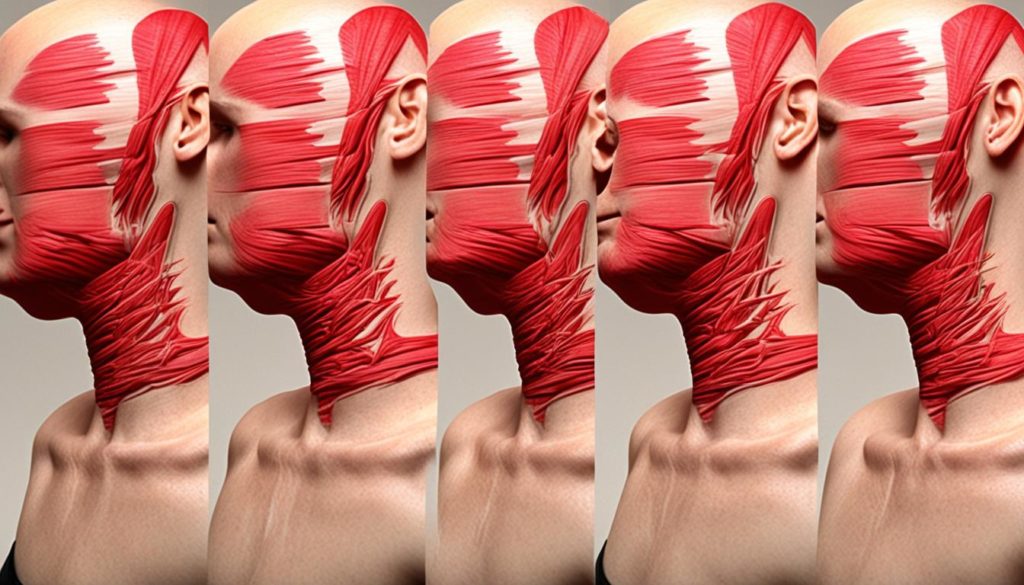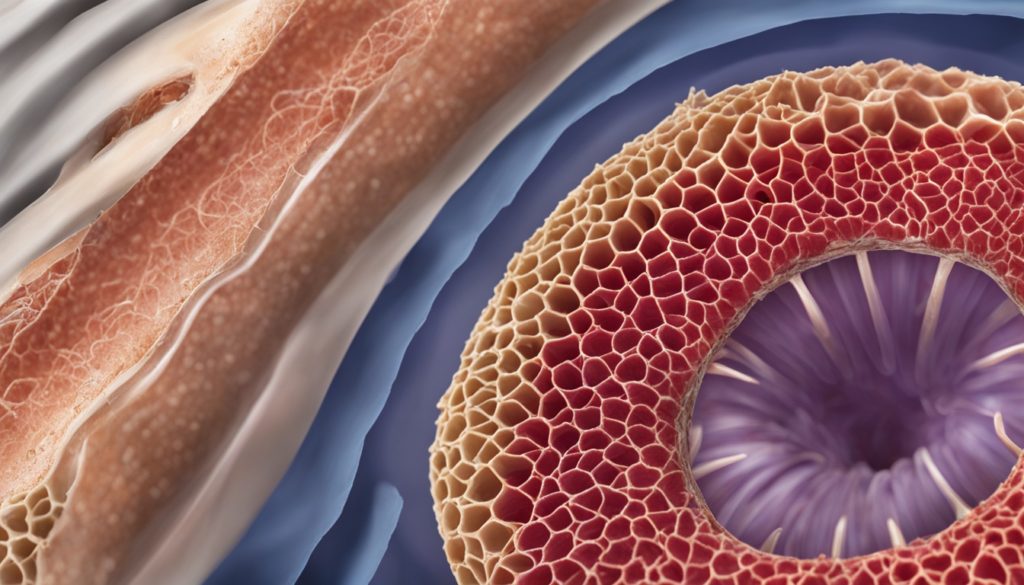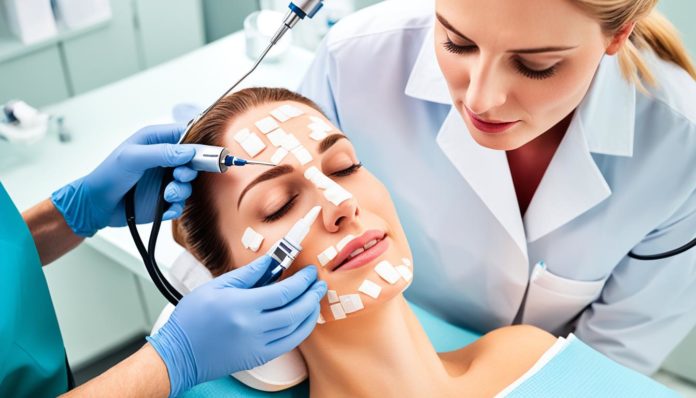About 11% of African American males suffer from Acne Keloidalis Nuchae (AK). This shows the unique problems this group faces. Acne Keloidalis is a serious skin issue. It needs a deep understanding and specific treatments to be managed well.
Acne Keloidalis is a long-term skin problem seen mostly in men with curly hair. It causes firm, raised bumps that can scar and sometimes lead to hair loss. The exact causes of Acne Keloidalis are still unclear. But, genetics, environment, and hormones might play a role. Getting the right treatment early can make a big difference.
Key Takeaways
- Acne Keloidalis affects approximately 11% of African American males.
- This chronic skin condition involves firm, raised lesions that can lead to scarring and hair loss.
- Factors contributing to Acne Keloidalis include genetics, environmental conditions, and hormonal influences.
- Early recognition and proper AK treatment options are crucial for effective management.
- A holistic approach, including lifestyle changes, can help in Acne Keloidalis management.
What is Acne Keloidalis?
Acne Keloidalis Nuchae, often called AKN, is a special type of skin condition. It mainly shows up on the neck’s back and the scalp behind. This condition is different from regular acne because it forms keloid-like bumps and nodules. These can get red, swollen, and painful.
Definition and Overview
Acne Keloidalis Nuchae is a long-lasting skin issue that leads to hard bumps and scars on the neck. First known as “dermatitis papillaris capillitii,” it often occurs in people with curly hair, especially African American men. The cause is not fully understood but might involve both genes and the environment.

Common Symptoms
The symptoms of AK can range from minor to major, affecting how one feels about themselves. The main signs include:
- Firm bumps and nodules on the back of the neck or head
- Itching and discomfort in these areas
- Possibility of abscesses or sores forming
- In bad cases, scarring and losing hair
Knowing these AK symptoms early on can help in managing Acne Keloidalis Nuchae. It also helps prevent worse issues later on with this stubborn skin condition.
Causes of Acne Keloidalis
To effectively manage and prevent Acne Keloidalis, it’s key to understand its causes. It often results from a mix of genetics, the environment, and hormones.

Genetic Factors
Genetics play a major role in Acne Keloidalis. If your family has a history of keloids, you’re more likely to get it. This is because some families are more prone to skin issues.
Environmental Triggers
Hair grooming habits significantly affect Acne Keloidalis. Bad shaving practices can irritate the skin. Wearing tight clothes around the neck can also make it worse.
Hormonal Influences
Hormonal shifts are important in understanding Acne Keloidalis. When androgen levels go up, due to puberty or other reasons, it can make the condition worse. This is because they increase sebum and block hair follicles.
| Factor | Impact on Acne Keloidalis |
|---|---|
| Genetic Predisposition | Increases risk, particularly with family history of keloids |
| Hair Grooming Practices | Improper shaving and tight collars can cause follicular Inflammation |
| Hormonal Changes | Fluctuations in androgen levels can worsen the condition |
Symptoms of Acne Keloidalis Nuchae
Acne Keloidalis Nuchae (AKN) starts as skin bumps on the neck’s back and the scalp. These bumps first show up as small, itchy spots. They slowly grow into bigger, more visible lesions. Signs like redness, swelling, and scars can appear if it’s not treated.
A key sign of AKN is keloid-like nodules forming. These skin bumps can merge into bigger patches. This merging can cause cosmetic worries and even hair loss where the bumps are. People often feel discomfort, with the lesions getting sore or painful when the condition is active.
As AKN gets worse, pus-filled spots might show up, suggesting a bacterial infection might be there. How bad the Acne Keloidalis Symptoms get can change a lot from person to person. This depends on things like genes and the condition of the scalp. Chronic cases can lead to a lot of discomfort and shame because the bumps and scars are very noticeable.
| Symptom | Description |
|---|---|
| Initial Bumps | Small, itchy papules on the scalp and neck. |
| Redness & Inflammation | Swollen areas with a reddish hue, indicating inflammation. |
| Keloid Nodules | Firm nodules that can merge into larger plaques. |
| Pain & Discomfort | Tenderness and pain in affected areas. |
| Pustules | Development of pus-filled lesions, indicative of infection. |
Spotting these symptoms early is key to treating AKN in time. Watching for changes in scalp conditions is important. This helps avoid the worse issues of Acne Keloidalis Symptoms.
Diagnosis Process for Acne Keloidalis
Understanding the AK Diagnosis process is vital for those with symptoms of Acne Keloidalis. Dermatologists aim to fully understand the patient’s health to plan treatment. The process usually starts with a consultation and includes diagnostic tests.
Initial Consultation
The first visit is key in the Dermatological Evaluation of Acne Keloidalis. A dermatologist will ask about the patient’s health history and symptoms. This helps them get a clear picture of the condition. They also examine the skin closely, looking for signs like the pattern and severity of lesions.
Diagnostic Tests
After the first visit, tests are important for the AK Diagnosis. One common test is the Biopsy, where a small piece of skin is checked under a microscope. It helps rule out other skin issues. Sometimes, imaging tests are done to look deeper into the skin. These tests help the dermatologist make a clear diagnosis and suggest the right treatment.
| Diagnostic Step | Description |
|---|---|
| Initial Consultation | Collection of patient’s medical and family history, detailed question-answer session, and physical examination of affected areas. |
| Biopsy | A minor surgical procedure where a tissue sample is taken for microscopic examination to confirm Acne Keloidalis. |
| Imaging Tests | Optional tests to explore deeper skin and subcutaneous involvement. |
Acne Keloidalis Treatment Options
Dealing with Acne Keloidalis can feel overwhelming. However, knowing your treatment choices can make a big difference. Dermatologists offer many options that fit your specific needs, making it easier to manage the condition.
Topical Treatments
Topical treatments are often the first step. Corticosteroid creams help ease inflammation and itching. They are useful in mild cases to control symptoms and stop new growths. Also, using antimicrobial cleansers daily can fight off bacteria.
Oral Medications
In tougher cases, doctors might suggest oral medications. Antibiotics fight infection and lower inflammation. These drugs attack the bacteria causing trouble, helping to ease ongoing symptoms. Teaming them with topical treatments often works better.
Surgical Procedures
More severe Acne Keloidalis might need surgery. Surgical removal gets rid of keloid scarring and problematic follicles. Sometimes, cryotherapy is used too. It freezes off abnormal tissue, proving to be good at shrinking keloid scars.
Laser Therapy
Laser therapy is a new, effective choice for Acne Keloidalis. It uses focused light to take out bad tissue and help healing. It’s great at making keloid scars smaller without big surgery. Patients often see much better skin texture and look after laser sessions.
| Treatment Option | Primary Use | Benefits | Drawbacks |
|---|---|---|---|
| Corticosteroid Creams | Reduce inflammation | Easy to apply, widely available | May cause skin thinning with prolonged use |
| Antibiotics | Combat infection | Reduces bacterial load, decreases inflammation | Possible side effects, antibiotic resistance |
| Surgical Procedures | Remove keloid scars | Effective for advanced cases | Invasive, potential for scarring |
| Laser Therapy | Target keloid scars | Minimally invasive, promotes healing | May require multiple sessions |
Management and Prevention Strategies
Effectively managing Acne Keloidalis (AK) combines AK Prevention and long-term care. Following a detailed treatment plan closely can lessen new lesions. It also keeps the skin healthy over time.
Scar Prevention is key for patients. Topical treatments like corticosteroids and retinoids can reduce scarring. It’s crucial to use these as a dermatologist directs for the best outcomes.
Lifestyle changes are vital in Long-Term Management. Cleaning the area with gentle, non-comedogenic cleansers helps keep the skin clean and outbreak-free. Loose clothing reduces skin friction and irritation, aiding in AK Prevention.
A skincare routine for sensitive skin increases treatment success. Staying away from harsh hair products and moisturizing regularly strengthens the skin.
Working closely with healthcare providers is important for continual management. Frequent check-ups and adjusting the treatment plan suit personal needs. This reduces worsening conditions and helps in Scar Prevention. Laser therapy is an option for tough cases, discussable with a dermatologist.
Here’s a quick guide to Management and Prevention Strategies:
- Use a topical treatment plan prescribed by your dermatologist.
- Make lifestyle changes such as opting for loose-fitting clothes.
- Keep up with a gentle skincare routine.
- Have regular meetings with healthcare specialists.
- Explore advanced treatments for stubborn AK.
Lifestyle Changes for Managing AK
Making certain lifestyle changes can really help with Acne Keloidalis. These changes include eating right and following a good skincare routine. They highlight the need to avoid things that can irritate the skin. And, they stress keeping the skin clean.
Dietary Adjustments
Good food is key for healthy skin. It can play a big role in managing Acne Keloidalis. Eating anti-inflammatory foods like berries, nuts, and leafy greens can lower skin inflammation. You should avoid sugary and highly processed foods.
“Dietary changes can have a profound impact on skin health, particularly for those managing chronic conditions like Acne Keloidalis.” – Dr. Sarah Smith, Dermatologist
Skincare Routine
For those dealing with Acne Keloidalis, having the right skincare routine is crucial. Using gentle cleansers that don’t block pores is a good move. It’s important to clean affected areas regularly and steer clear of things that irritate the skin. Like harsh soaps and tight clothes. These steps can help avoid making things worse.
| Skincare Tips | Description |
|---|---|
| Use Gentle Cleansers | Choose products that do not irritate or clog pores. |
| Avoid Tight Clothing | Opt for loose-fitting clothing to reduce skin friction. |
| Regularly Moisturize | Maintains skin hydration and reduces irritation. |
Living with Acne Keloidalis: Personal Experiences
Acne Keloidalis affects people deeply, not just on their skin, but emotionally too. By sharing stories from those living with it, we aim to build understanding. This helps everyone see the importance of compassion and community support.
Patient Stories
Daniel has lived with Acne Keloidalis for over ten years. He talks about how it shook his confidence at first. He found strength through a dermatologist who really gets how tough the condition is.
Maria found hope in online support groups. She learned practical tips and felt emotionally supported by people who get it. Her story shows how vital a support network is.
Support Groups
Support groups are key for those dealing with Acne Keloidalis. They offer a place to share stories, advice, and support. Online forums on Reddit and Facebook have helped many people.
For in-person support, local groups meet to discuss their experiences and coping strategies. These meetings give a sense of community and share useful knowledge on managing the condition.
Conclusion
Understanding Acne Keloidalis deeply is crucial for those affected by it. It involves a range of factors, from genetics to the environment. Knowing these can help in finding the right treatment and managing it well.
Good skin care is very important. A consistent and suitable skincare routine is key to manage symptoms.
Looking into different treatments is beneficial. This can include creams, pills, surgery, or laser therapy. Adding changes in diet and skincare habits can lead to better results. Stories from others and support groups also show how vital support is.
Being proactive in seeking medical advice and looking after oneself is essential. Talking to doctors for proper diagnosis and treatment plans is needed for the best care. Having support makes a big difference in living with this condition.
FAQ
What is Acne Keloidalis?
Acne Keloidalis Nuchae is a long-term skin issue. It features raised, scar-like bumps on the neck’s back. Unlike typical acne, it leaves scars and doesn’t always respond to usual acne treatments.
What are the typical symptoms of Acne Keloidalis?
Symptoms start with small, hard bumps. They can get sore and turn into larger nodules. These often appear on the neck’s lower part, bring itchiness, pain, and can lead to scars. With time, they may grow into bigger keloid plaques.
What are the main causes of Acne Keloidalis?
It’s caused by genes, certain life factors like how you groom your hair, hormones, and inflammation. Often, clothes rubbing or shaving injuries make it worse.
How is Acne Keloidalis diagnosed?
A skin doctor, or dermatologist, starts with your medical background and a physical check. They may also do skin tests to make sure it’s Acne Keloidalis and not another scalp issue.
What treatment options are available for Acne Keloidalis?
Treatments include creams, antibiotics, surgery for big bumps, and laser. Doctors craft the treatment plan for each person, sometimes combining therapies for the best outcome.
How can one manage and prevent Acne Keloidalis?
Managing it means sticking to your treatment and maybe changing some daily habits to prevent more flare-ups. Helpful tips are staying clean, avoiding tight clothes and neck injuries, and eating well.
Are there any recommended lifestyle changes for managing Acne Keloidalis?
Helpful changes include skin-friendly routines, gentle hair care, and good cleanliness. Eating better might also reduce skin flare-ups.
How can personal support and community involvement help those living with Acne Keloidalis?
Dealing with this condition can be tough on your emotions and social life. Sharing your story in support groups or online can help. It lessens the emotional weight and makes you feel part of a community.


